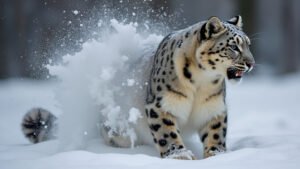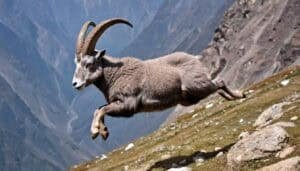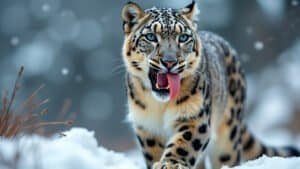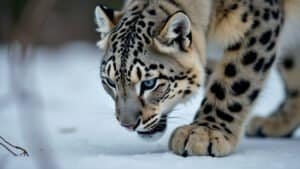Introduction
The hunting success of snow leopards, one of the most elusive big cats, is intricately tied to the density of prey in their rugged habitats. Understanding how these majestic predators adapt their hunting strategies based on the availability of prey is crucial for conservation efforts
This article explores the relationship between prey density and snow leopard hunting success, examining how variations in prey availability impact their hunting behavior, energy expenditure, and overall survival
We will delve into the challenges they face in low prey density areas, the role of terrain, and the seasonal fluctuations that influence their hunting success rates
Snow Leopards’ Hunting Success in High Prey Density Areas
Snow leopards, known for their elusive nature and stealthy hunting techniques, thrive in environments where prey is abundant. In regions with high prey density, these predators can capitalize on the increased availability of food sources, leading to higher hunting success rates
The presence of numerous prey species such as blue sheep, ibex, and other ungulates in these areas provides snow leopards with ample opportunities to hunt with greater frequency and less effort
This section examines how high prey density positively influences the hunting efficiency of snow leopards, enabling them to maintain their energy levels, reproductive success, and overall population stability
Understanding Prey Density Metrics
Prey density refers to the number of prey animals per unit area in a given habitat, a crucial factor influencing predator success rates. For snow leopards, prey density can be quantified by studying the population of primary prey species such as blue sheep (Pseudois nayaur) and Siberian ibex (Capra sibirica)
Research conducted in regions like the Himalayas and the Altai Mountains reveals that areas with a high concentration of these ungulates typically see a corresponding increase in snow leopard activity
Prey density is often measured using methods such as transect surveys, camera trapping, and direct observation of prey herds. In a study by McCarthy et al. (2016), it was found that snow leopards’ hunting success was directly correlated with prey density, particularly in areas where the prey population exceeded 30 individuals per square kilometer
This high density allows snow leopards to conserve energy by reducing the distance they must travel to locate and hunt prey
Correlation Between Prey Abundance and Hunting Success
In ecosystems with high prey density, snow leopards exhibit a marked increase in hunting success. Studies have shown that when prey is abundant, these predators are more likely to make successful kills within a shorter period
According to Schaller (1977), snow leopards in regions with dense prey populations achieve success in about 30% of their hunting attempts. This rate is significantly higher compared to areas with sparse prey, where the success rate can drop below 10%
The abundance of prey also allows snow leopards to employ a more energy-efficient hunting strategy. Instead of engaging in lengthy and exhaustive chases, snow leopards in high prey density areas can afford to stalk and ambush their prey from shorter distances
This reduction in energy expenditure is vital for their survival, particularly in the harsh, cold environments they inhabit, where conserving energy is crucial
Case Studies in Regions With High Prey Density
Several regions across the snow leopard’s range have been studied to understand the impact of prey density on hunting success. In the Tost Mountains of Mongolia, where ibex and argali sheep populations are relatively high, snow leopards have been observed to have one of the highest hunting success rates
A study by Kachel et al. (2020) reported that snow leopards in this region had a hunting success rate of approximately 35%, attributed to the large herds of ungulates present
Similarly, in the Spiti Valley of India, where blue sheep are the predominant prey, snow leopards exhibit a success rate of around 32%, according to Lovari et al. (2009). These figures suggest that in areas where prey is abundant, snow leopards can hunt more effectively, ensuring they meet their dietary needs with less effort
However, it is important to note that even in high prey density areas, hunting success is not guaranteed. Factors such as terrain, weather conditions, and human disturbances can still affect the ability of snow leopards to secure a kill
For instance, steep and rocky terrain can provide prey with ample opportunities to escape, even when prey density is high. Moreover, human activities, including livestock grazing and poaching, can disrupt the natural prey base, leading to a temporary decline in snow leopard hunting success
Challenges Faced by Snow Leopards in Low Prey Density
In areas where prey density is low, snow leopards face significant challenges that can severely impact their survival. The scarcity of prey forces these elusive predators to expend more energy in search of food, often leading to reduced hunting success rates and longer intervals between kills
This section delves into how low prey density affects snow leopards’ hunting behavior, the adaptive strategies they employ to cope with these challenging conditions, and the broader implications for their health, reproduction, and overall population dynamics
Understanding these challenges is crucial for developing effective conservation strategies in regions where prey populations are declining
Impact of Scarcity on Hunting Behavior
In regions where prey density is low, snow leopards must adapt their hunting strategies to cope with the scarcity of food. Low prey density typically means that these predators have to cover larger territories and travel greater distances to locate potential prey
A study by Hunter and Barrett (2018) found that in areas with low prey density, such as parts of the Pamir Mountains, snow leopards often traverse over 25 miles in a single hunt, compared to less than 10 miles in high-density regions
This increased range requires snow leopards to utilize more energy, which can be detrimental in the cold, harsh environments they inhabit. Moreover, the scarcity of prey leads to a decrease in hunting success rates
According to a study by Lovari et al. (2009), snow leopards in low prey density areas often succeed in less than 10% of their hunting attempts, significantly lower than in areas with abundant prey
Adaptive Strategies in Low Density Conditions
To cope with low prey density, snow leopards have developed several adaptive strategies. One key adaptation is their highly solitary nature, which reduces competition for limited resources. Unlike some other big cats that may hunt in groups or pairs, snow leopards almost exclusively hunt alone, which allows them to maximize the available prey without having to share
Another adaptation is their ability to endure long periods without food. Snow leopards can survive on a single large kill, such as a blue sheep or ibex, for up to two weeks
During times of scarcity, they are known to return to a kill multiple times, guarding it against scavengers and feeding on it until nothing remains. This behavior helps them conserve energy and survive in environments where food is not always readily available
In addition to these behavioral adaptations, snow leopards have also evolved physiological traits that help them endure the challenges of low prey density. For instance, their thick fur and large nasal cavities are adaptations that allow them to survive in the cold, high-altitude environments where prey is often sparse
These adaptations minimize their energy expenditure on maintaining body heat, allowing them to allocate more energy to hunting and survival
Effects on Snow Leopard Health and Reproduction
The challenges posed by low prey density have significant effects on snow leopards’ health and reproductive success
Prolonged periods without food can lead to malnutrition, which in turn affects their ability to reproduce. Studies have shown that snow leopards in areas with low prey density often have lower body weights and poorer overall health compared to those in prey-rich regions
Malnutrition also affects reproductive success. Female snow leopards in low prey density areas are less likely to successfully rear cubs to adulthood
A study by McCarthy et al. (2016) found that in regions where prey was scarce, the survival rate of snow leopard cubs was significantly lower, with many cubs not surviving their first year due to the inability of the mother to provide adequate food
Furthermore, low prey density can lead to increased human-wildlife conflict. In areas where natural prey is scarce, snow leopards may turn to livestock as an alternative food source. This behavior not only endangers the snow leopards, as they are often killed in retaliation by herders, but also exacerbates their already precarious situation by reducing their natural prey base even further
Seasonal Variations in Prey Density and Their Impact
Seasonal changes play a significant role in the availability of prey for snow leopards, directly influencing their hunting success. As prey species migrate, breed, or alter their behavior in response to seasonal shifts, snow leopards must adapt their hunting strategies accordingly
This section explores how seasonal variations in prey density affect snow leopards, focusing on the challenges and opportunities these predators face during different times of the year. By understanding these seasonal dynamics, we gain insight into the intricate balance of snow leopards’ survival and the importance of timing in their hunting efforts
Seasonal Movements of Prey Species
The prey species that snow leopards rely on, such as blue sheep, ibex, and Himalayan tahr, often undergo seasonal migrations in search of food and better climatic conditions
These migrations result in significant fluctuations in prey density within snow leopard territories throughout the year. For instance, during the summer months, many ungulate species move to higher altitudes where food is more abundant, leading to a temporary increase in prey density in these regions
However, in the winter, when harsh weather conditions drive prey to lower altitudes, snow leopards may find themselves in areas with significantly reduced prey density. This seasonal migration of prey presents a challenge for snow leopards, as they must either follow the prey to new areas or adapt to the reduced availability of food in their current locations
Research by Schaller (1977) highlights how snow leopards in the Himalayas must often travel extensive distances during winter to locate adequate prey, leading to increased energy expenditure and reduced hunting success
Changes in Snow Leopards’ Hunting Success Over Seasons
The seasonal variation in prey density has a direct impact on the hunting success of snow leopards. During the summer, when prey is more abundant and concentrated in certain areas, snow leopards are likely to experience higher hunting success rates
The concentration of prey in smaller areas allows snow leopards to hunt more efficiently, conserving energy and increasing their chances of making a successful kill
In contrast, the winter months can be particularly challenging. As prey becomes more dispersed and harder to locate, snow leopards often struggle to maintain their hunting success. Studies have shown that in some regions, the success rate of snow leopards can drop by as much as 50% during the winter compared to the summer
This seasonal decline in hunting success is not only due to the scarcity of prey but also the harsher environmental conditions that make hunting more difficult. Deep snow, cold temperatures, and limited daylight hours all contribute to the challenges snow leopards face during the winter
Long-Term Impacts of Seasonal Prey Fluctuations
The seasonal fluctuations in prey density and the associated challenges can have long-term impacts on snow leopard populations
Prolonged periods of low prey availability, particularly during harsh winters, can lead to malnutrition, weakened immune systems, and decreased reproductive success. Snow leopards that are unable to secure enough food during these periods may struggle to survive, let alone reproduce and rear healthy cubs
Moreover, the stress of finding food during the winter can lead snow leopards to take greater risks, such as preying on livestock. This behavior often results in increased human-wildlife conflict, which can have fatal consequences for snow leopards. In some areas, retaliatory killings by herders are a significant threat to snow leopard populations, exacerbated by the seasonal scarcity of natural prey
In the long term, if seasonal prey fluctuations continue to impact snow leopard hunting success negatively, it could lead to population declines in affected regions
Conservation efforts must, therefore, take into account the seasonal dynamics of prey species and ensure that snow leopards have access to adequate food sources throughout the year. Protecting migration corridors, managing prey populations, and mitigating human-wildlife conflict are essential strategies for supporting snow leopards during these challenging seasonal periods
The Role of Terrain and Environment in Hunting Success
The rugged terrain and harsh environments that snow leopards inhabit play a crucial role in their hunting success. These big cats are perfectly adapted to the steep, rocky landscapes of the Himalayas and other mountainous regions, where they use the terrain to their advantage when hunting
This section explores how the physical environment influences snow leopards’ ability to stalk and capture prey, the challenges they face in different terrains, and the adaptive strategies they employ to overcome these obstacles. Understanding the interplay between terrain and hunting success is vital for conserving these elusive predators in their natural habitats
How Terrain Influences Prey Distribution
The terrain in snow leopard habitats is often characterized by steep cliffs, rocky outcrops, and deep valleys, which significantly influence the distribution of prey species
Prey animals such as blue sheep, ibex, and Himalayan tahr are also highly adapted to these environments, often congregating in areas where the terrain provides safety from predators. These ungulates prefer steep slopes and rugged landscapes where they can easily escape from predators, making the terrain both a challenge and an opportunity for snow leopards
For snow leopards, the ability to navigate these complex terrains is a key component of their hunting strategy. The steep and uneven landscapes allow snow leopards to approach prey with stealth, using natural cover such as rocks and vegetation to remain undetected until they are within striking distance
A study by Jackson and Ahlborn (1988) noted that snow leopards often position themselves above their prey on steep slopes, using gravity to their advantage during the final pounce. This strategic use of terrain allows snow leopards to increase their chances of a successful kill, despite the difficult hunting conditions
Snow Leopards’ Use of Terrain to Maximize Success
Snow leopards are masters of their mountainous environment, using the terrain not only to approach prey undetected but also to gain the upper hand during the hunt
Their powerful limbs, strong muscles, and long tails provide them with the balance and agility needed to move swiftly across rocky surfaces and navigate vertical landscapes with ease. This physical prowess enables them to pursue prey in areas where other predators would struggle, giving them a unique advantage in these challenging environments
One of the key tactics employed by snow leopards is the use of ambush points. They often wait in areas where the terrain naturally funnels prey into narrow paths or steep inclines, reducing the prey’s ability to escape
By positioning themselves strategically, snow leopards can launch surprise attacks with a higher likelihood of success. This ambush strategy is particularly effective in regions with broken, rocky terrain, where prey has limited options for evasion
Furthermore, snow leopards often hunt during the early morning or late evening when the lighting conditions are low. This not only gives them a better chance of remaining undetected but also takes advantage of the cooler temperatures, which help them conserve energy during the chase
The ability to adapt their hunting techniques to the specific characteristics of the terrain and environment is a testament to the snow leopard’s incredible adaptability and survival skills
Comparative Studies in Different Habitats
Snow leopards inhabit a range of environments across their vast range, from the snowy peaks of the Himalayas to the arid mountains of Central Asia. Comparative studies have shown that the specific terrain and environmental conditions of each region can greatly influence hunting success
For instance, in the Altai Mountains, where the landscape is characterized by wide-open valleys interspersed with rocky cliffs, snow leopards rely heavily on the cliffs for stalking prey. A study by McCarthy et al. (2010) found that snow leopards in this region had higher success rates when hunting in areas with a greater concentration of rocky outcrops, which provided ample cover for ambush
In contrast, snow leopards in the more open, less rugged terrains of the Tibetan Plateau face different challenges. The lack of dense vegetation and rocky cover means that these predators must rely more on their speed and endurance to chase down prey over longer distances
Studies have indicated that in these less rugged environments, snow leopards may have lower hunting success rates compared to their counterparts in more mountainous regions. This variation underscores the importance of terrain in shaping the hunting strategies and success of snow leopards
Moreover, environmental factors such as snow cover and temperature also play a significant role. Deep snow can hinder both the predator and the prey, making hunts more difficult and energy-intensive
However, snow leopards have adapted to these conditions with their large, fur-covered paws that act like snowshoes, distributing their weight more evenly and allowing them to move more efficiently in deep snow. These adaptations highlight the snow leopard’s ability to survive and hunt in some of the most extreme environments on Earth
Conclusion
Snow leopards’ hunting success is a complex interplay of factors, with prey density, seasonal variations, and the challenging terrain of their habitats playing pivotal roles. In regions with high prey density, snow leopards enjoy greater hunting success, which supports their overall health and reproduction
Conversely, low prey density poses significant challenges, forcing these predators to expand their territories and adapt their hunting strategies, often with lower success rates and greater energy expenditure. Seasonal fluctuations further complicate their survival, as prey availability changes with the seasons, requiring snow leopards to adapt to both abundance and scarcity
The rugged terrain, while offering both challenges and opportunities, is essential to their hunting strategy, allowing them to use the environment to their advantage. Understanding these dynamics is crucial for effective conservation efforts. By maintaining healthy prey populations, protecting migration corridors, and preserving the natural landscapes that snow leopards rely on, we can help ensure the survival of this majestic species in the wild













